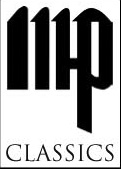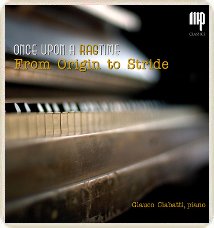GLAUCO CIABATTI

Il Ragtime è il primo contributo dell'America alla letteratura musicale e può essere considerato la prima forma d'arte propriamente e genuinamente americana oltre ad essere il precursore del Jazz e in definitiva di tutta la musica moderna.
La sua nascita coincide di fatto con la fine della guerra di secessione (1865): i neri, liberati dalla schiavitù, scelsero fra i tanti mestieri anche di intrattenere gli ex-padroni bianchi suonando il pianoforte dovunque potesse capitare. Il repertorio richiesto era di tipo popolare: marce, gighe, quadriglie, valzer ed altre danze europee. A questo punto la natura essenzialmente melodica della musica popolare europea, "esportata" in America, si fondeva con la natura principalmente ritmica degli africani (o afroamericani): quelle che erano danze scozzesi o gighe, nel giro di pochi decenni diventarono rags.
Volendo analizzare etimologicamente la parola "ragtime", bisogna risalire al verbo "to rag" cioè "stracciare": ragtime vuol dire "tempo spezzato" (il sostantivo "rag" indica letteralmente un pezzo di stoffa lacerata dal lungo uso). Caratteristica del Ragtime è proprio il contrasto tra una melodia "spezzata" o, più tecnicamente, "sincopata" e un accompagnamento rigorosamente regolare: questo è in pratica la base di tutta la musica moderna.
La nascita ufficiale del Ragtime si fa coincidere con la pubblicazione, nel 1897 a Chicago, dello spartito di MISSISSIPPI RAG, composta dal musicista bianco William Krell. In tale città era stata importante per lo sviluppo del Ragtime l'Esposizione Colombiana del 1893 che originò un fruttuoso periodo di aggregazione per molti musicisti soprattutto neri.
A partire da quel periodo il Ragtime diventa una mania collettiva che mette in ombra tutti i generi musicali allora in voga e lo strumento principe è il pianoforte solista.
Verso la fine dello stesso anno (1897) viene pubblicato anche il primo ragtime composto da un nero: HARLEM RAG del pianista Tom Turpin, il quale gestiva un locale a St. Louis, il famoso Rosebud Cafè.

The Ragtime is the first American contribution to music literature and can be considered the first art form properly and genuinely American as well as being the precursor of Jazz and ultimately of all modern music.
His birth actually coincides with the end of the Civil War (1865): black people, freed from slavery, chose among many trades also to entertain former white owners playing the piano in any place they could find. The repertoire required was of popular type: marches, jigs, quadrilles, waltzes and other European dances. At that point the essentially melodic nature of European popular music, "exported" in America, merged with African (or Afro-American) rhythm: those who were Scottish dances and jigs, in few decades became rags.
To analyze etymologically the word "ragtime", we must go back to the verb "to rag" ie "tear up": ragtime means "broken time" ("rag" is literally a piece of cloth torn from long use). Characteristic of Ragtime is the contrast between a "broken" or, more technically, "syncopated" melody and a strictly regular accompaniment: this is the basis of all modern music.
The official birth of Ragtime coincides with the publication, in 1897 in Chicago, of the score of MISSISSIPPI RAG, composed by white musician William Krell. In this city the Columbian Exposition of 1893 played an important role in the development of Ragtime and originated a fruitful period of aggregation for many musicians, especially black. From that time the Ragtime become a craze that outshines all kinds of music in vogue, and the piano solo was its main instrument. Towards the end of the same year (1897) the first ragtime composed by a black person is also published: HARLEM RAG by the pianist Tom Turpin, who managed a pub in St. Louis, the famous Rosebud Cafè.
Un breve accenno ... del nuovo
CD ... "buon ascolto"
|
|
01. MISSISSIPPI RAG - William H. Krell - 1897 - 3'27 |
|
|
02. HARLEM RAG - Tom Turpin - 1897 - 2'33
|
|
|
03. ORIGINAL RAGS -Scott Joplin - 1899 - 3'46 |
|
|
04. MAPLE LEAF RAG - Scott Joplin - 1899 - 2'46
|
|
|
05. THE ENTERTAINER - Scott Joplin - 1902 - 3'39 |
|
|
06. PLEASANT MOMENTS - Scott Joplin - 1909 - 2'54 |
|
|
07. THE RAGTIME NIGHTINGALE - Joseph Lamb - 1915 - 3,45 |
|
|
08. GOPATRICIA RAGON - Joseph Lamb - 1916 - 2'59 |
|
|
09. HILARITY RAG - James Scott - 1910 - 2'44 |
|
|
10. RAGTIME ORIOLE - James Scott - 1911 - 4'34 |
|
|
11. BLACK & WHITE RAG - George Botsford - 1908 - 2'40 |
|
|
12. HOT-HOUSE RAG - Paul Pratt - 1914 - 2'53 |
|
|
13. CHARLESTON RAG - Eubie Blake - 1917 - 3'30 |
|
|
14. KITTEN ON THE KEYS - Zez Confrey - 1921 - 3'15 |
|
|
15. STRATFORD HUNCH - Jelly "Roll""Morton - 1926 - 4'01 |
|
|
16. DAINTINESS RAG - James P. Johnson - 1947 - 3'23 |
| |
Etichetta MAP CLASSICS

Catalogo N° MAPCL 10012
Anno 2015 |
Produzione
esecutiva
M.A.P. EDITIONS S.r.l.
Distribuzione
M.A.P. EDITIONS |
|
questo
prodotto è acquistabile al
prezzo
di €uro 12,99
più spese di spedizione
(clicca qui) |
|
o
in alternativa direttamente sul
nostro sito MAP SHOP,
con
pagamento con
Carta di Credito
(clicca
qui) |
| |
|
|
|
|
|
|


